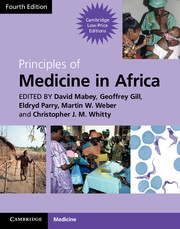Book contents
- Frontmatter
- Contents
- Contributors
- Foreword
- Section 1 Health and disease
- Section 2 Mother and child health
- Section 3 Infection: general principles
- Section 4 Major common infections
- Section 5 Bacterial infections
- 22 Typhoid, paratyphoid and non-typhoid Salmonella infections
- 23 Streptococcus pyogenes and Staphylococcus aureus
- 24 Rickettsial infections
- 25 Brucellosis
- 26 Leptospirosis
- 27 Relapsing fever
- 28 Plague
- 29 Anthrax
- 30 Tetanus
- 31 Diphtheria
- 32 Leprosy
- 33 Cholera
- Section 6 Viral Infections
- Section 7 Protozoal infections
- Section 8 Helminth infections
- Section 9 Fungal infections
- Section 10 Non-communicable diseases
- Section 11 Diseases of body systems
- Section 12 Cancer and Palliative Care
- Section 13 Venoms and Poisons
- Index
- References
32 - Leprosy
from Section 5 - Bacterial infections
Published online by Cambridge University Press: 05 March 2013
- Frontmatter
- Contents
- Contributors
- Foreword
- Section 1 Health and disease
- Section 2 Mother and child health
- Section 3 Infection: general principles
- Section 4 Major common infections
- Section 5 Bacterial infections
- 22 Typhoid, paratyphoid and non-typhoid Salmonella infections
- 23 Streptococcus pyogenes and Staphylococcus aureus
- 24 Rickettsial infections
- 25 Brucellosis
- 26 Leptospirosis
- 27 Relapsing fever
- 28 Plague
- 29 Anthrax
- 30 Tetanus
- 31 Diphtheria
- 32 Leprosy
- 33 Cholera
- Section 6 Viral Infections
- Section 7 Protozoal infections
- Section 8 Helminth infections
- Section 9 Fungal infections
- Section 10 Non-communicable diseases
- Section 11 Diseases of body systems
- Section 12 Cancer and Palliative Care
- Section 13 Venoms and Poisons
- Index
- References
Summary
The problem in Africa
Leprosy is a chronic disease predominantly affecting skin and nerves, which may result in deformity, disability and social stigma, creating problems for patients and their families. Africa is the third most affected region world-wide after Asia and South America (WHO, 2009). In 2009, eight African countries still reported more than one new leprosy case per 10 000 population.
In many countries leprosy work is being integrated into general health services, so all medical professionals need to be aware of the symptoms and signs of leprosy. Since new patients may have nerve function impairment at diagnosis, every health professional should know how to assess and manage nerve impairment caused by leprosy (Rijk et al., 1994).
The organism
Leprosy is caused by Mycobacterium leprae, an acid-fast intracellular organism not yet cultivated in vitro. The organism was first identified in the nodules of lepromatous leprosy patients by Hansen in 1873. M. leprae parasitizes skin macrophages and peripheral nerve Schwann cells.
M. leprae can be grown in the mouse footpad, but growth is slow. The nine-banded armadillo is susceptible to M. leprae infection, and develops disease with widespread bacterial multiplication. The armadillo and mouse models of M. leprae infection have been useful for producing M. leprae for biological studies and studying drug sensitivity patterns.
- Type
- Chapter
- Information
- Principles of Medicine in Africa , pp. 352 - 362Publisher: Cambridge University PressPrint publication year: 2013



